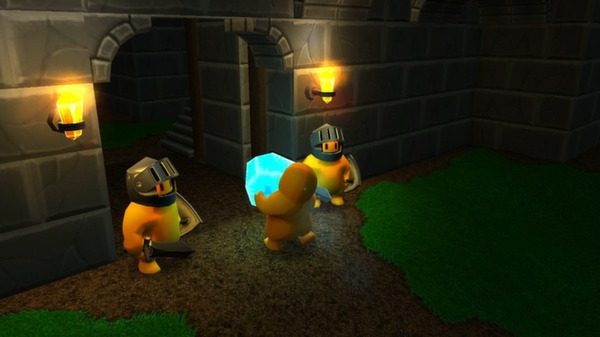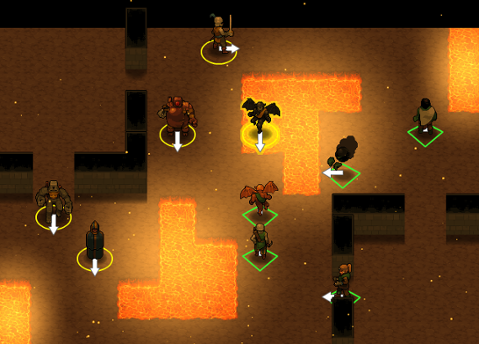[caption id="attachment_12677" align="aligncenter" width="618"]

Concept art from
Star Citizen, a space-combat game funded by Kickstarter.[/caption] When aspiring video game developer Germain Couët graduated from a game design studies program in 2010, most of his fellow students went off to get jobs with big studios. But Couët followed a different path: he co-created his own studio and started building a real-time strategy game called
Castle Story. To fund development, Couët and team went on Kickstarter, the crowdfunding site, and asked gamers to give at least $15 for early access to the game. The goal was to raise $80,000 in a 30-day period ending Aug. 26, 2012. They got
$702,516. Almost simultaneously, a famous game developer named Chris Roberts founded Cloud Imperium Games in Los Angeles. With decades in the business and a track record of success, Roberts could have gotten all the funding he needed from investment firms. Instead, Roberts did the same thing as Couët: he went on Kickstarter. Seeking money on both Kickstarter and his own site, Roberts has now raised
nearly $20 million (a record) toward the funding of
Star Citizen, a space trading and combat simulation game. Their stories, and literally thousands of others like them, illustrate the vast impact Kickstarter and other crowdfunding sites have on how video game development gets paid for. Hitting a Kickstarter goal is by no means easy; nor is completing the months or years of development needed to deliver a finished game. But just as the Internet fundamentally altered the way games are distributed from publishers to players, crowdfunding has upended the traditional models of raising money for development. Besides letting players choose which games get made in the first place, crowdfunding brings gamers and developers closer together, letting players offer input throughout the development process. In a typical Kickstarter, a project gets 30 days to hit a funding goal. Pledges aren’t deducted from contributors’ accounts unless the goal is reached. According to
Kickstarter statistics, 2,265 games have been successfully funded, while 4,194 game projects fell short of their funding goal. (That includes tabletop games in addition to video games.) 598 funded games raised at least $20,000, and 196 raised at least $100,000. Some 25 games raised at least $1 million each, giving games more million-dollar campaigns than all other categories combined. There have been some unfortunate outcomes, with games not being made due to technical errors or
developers just getting in over their heads. But it would be difficult to argue that Kickstarter, and similar sites like Indiegogo, haven’t had a positive impact on the industry.
No Money? No Problem
When Couët and François Alain co-founded Sauropod Studio in Montreal, “We didn't really have many options,” Couët told Slashdot. “Me and my co-founder had just recently graduated from game design studies. We had a choice to go work in the industry or to start a project on our own. Then we decided we didn't have anything to lose, so we decided to go for it.” They had little money, but they had an idea.
Castle Story for Windows and OS X would let players build castles brick by brick, and defend them against enemies, combining elements of
Minecraft and traditional tower defense games. [caption id="attachment_12678" align="aligncenter" width="600"]
 Castle Story
Castle Story.[/caption] “We worked on the game for about a year without any money, almost nothing. We had no funding options because we were newbies, we had no previous experience,” Couët said. Kickstarter was a “no-brainer,” he added, offering potentially high rewards with little risk. But Sauropod didn’t go to Kickstarter immediately. Throwing a half-baked idea on to the site without putting legwork in first is no path to success. Couët and team did their best to create a prototype and, crucially, a video to show it off. That 10-minute video, released in January 2012, went viral and earned nearly a million views. Their Kickstarter went live in July 2012 and raised nearly nine times as much as the team sought. Couët says he got a bit lucky, “surfing the
Minecraft wave.” But, “what I know we did right is we released a video with something that worked. I think if you want to make a Kickstarter that has success you need either a reputation, or you need to show people something that works. That’s why we worked on the game for about a year before talking to anyone about it.” With Kickstarter money in hand, Sauropod hired a few employees, upgraded its technology (moving from the free version of the
Unity game engine to the professional version), and kept on working. It’s paid off, as an
early-access version of Castle Storywas released on Steam this week. “It’s still early access so the game is really buggy and lacking a lot of features,” Couët said. The goal is to get “as much comments and feedback as possible” to help hone the finished product. [caption id="attachment_12679" align="aligncenter" width="618"]

At work in Montreal's Sauropod Studio.[/caption]
Crowdfunding Helps Both Newbies and Established Pros
Kickstarter isn’t just for recently graduated students or newcomers to the game industry. It’s also for people like the aforementioned Roberts, who created the well-known
Wing Commander series in 1990. After a stint producing movies, Roberts got back into the game business in 2012 with
Star Citizen for Windows. Roberts took a novel approach to crowdfunding, raising $2.1 million on Kickstarter last fall while conducting a simultaneous campaign on his own “Roberts Space Industries” site. While the Kickstarter had a 30-day window, the Roberts Space Industries crowdfund platform continues raising money to this day, bringing the total to $19.9 million. Backers can guarantee themselves a virtual spacecraft for $30. Roberts didn’t limit himself to just Kickstarter because he wanted as much interaction with fans during the development process as possible. The game isn’t scheduled to come out until mid-2015, but it should be available in an alpha stage by the end of 2014, and backers can already play with some pieces of the game. At each stage, fans provide feedback that might influence the final product. “We launched this hangar module a couple of weeks ago and there's hundreds of videos online, of people running around the hangar and doing crazy stuff,” Roberts told Slashdot. “It's pretty awesome because we're not wasting money on flashy TV ads. Every dollar is going into making a cool game.” Roberts initially lined up investors to fund most of the project, with Kickstarter intended primarily to prove that the public would be interested in the game. The financial support from individual backers was so overwhelming that Roberts had to give the investment firms some bad news: they were no longer needed. “Even nice investors, they want a return at some point. They have a slightly different agenda than I do,” Roberts said. “My agenda is to build the coolest game possible. If I get more money, I can have more spaceships and more environments and hire a few more people. That’s what I like. With an investor, more money means they want to have a bigger return.” The extra money raised through Kickstarter means the game will be more fully featured upon release. Unlike the old days of cartridge- and disc-based games, Roberts says
Star Citizen will continually receive upgrades years after it is released. But having $20 million instead of some lesser amount means more stuff will make it into the first version. For example, the minimum number of planets players can land on was initially planned to be 30. Now it’s going to be 450. Another bonus: first person combat is planned for the first release. “That was always part of our plan, but we were actually not going to do it until after we were live,” Robert said. “Everything we're really doing for
Star Citizen has always been part of my plan. The difference is we're able to deliver more of that master plan much sooner in the process.” Roberts has 100 people working on the game, and plans to get that up to 150 or 200. That includes himself, as he is the head of the company and a coder. Beyond the staff, the 250,000 gamers who’ve contributed to
Star Citizen development play an active role. “By the time we get to the live version the people that have backed us will have been playing with the final game for probably six months or seven months, and will have been playing with various facets of the game for a couple of years,” Roberts added.
Frustrating Failures Might Lead Players to Hit Pause
Kickstarter has certainly had its troubles, and those can be costly for people who back projects that never get completed or are indefinitely delayed. One game called
Haunts: The Manse Macabre hit its goal, raising $28,739, but failed to deliver due to a programming mistake
described on its Kickstarter page. The project leader implausibly blamed the problem on Google’s Go programming language, while admitting that “I don’t have the technical expertise to understand exactly” what went wrong. A Kickstarter game called
CLANG raised $526,125 from 9,023 backers, but still had money woes—and the developer decided to “
hit the pause button.” Other recent problems include Kickstarter suspending funding for a game “after questions were raised about the legitimacy of the accounts that were donating to the project,”
as Wired reported. In another case, PayPal had to
scramble for a fix after freezing funding for a few crowdfunding campaigns. Wharton Professor Ethan Mollick
surveyed 471 funded Kickstarter projects in the design and technology categories last year. Some 381 had clearly identifiable promises to backers. Total failure was rare, with just 11 projects ceasing all communication with backers and three issuing refunds. These failures were mostly concentrated in projects where relatively small amounts of money were raised. “Even though Kickstarter has no enforcement mechanism to prevent con artists from using the system to raise funds for fake projects, it is clear that with a direct failure rate well below 5 percent, founders appear to make attempts to deliver their projects,” Mollick wrote. Lateness was epidemic, however. Only 24.9 percent of the projects were delivered on time. Another 33 percent had yet to deliver by July 2012, the end of Mollick’s sample period, despite having promised rewards to backers sometime before that date. The mean delay for late projects was 2.4 months.
With Gamers’ Money, Old Classics are Revived
When Kickstarter works, though, it really works. Keiji Inafune, co-creator of the beloved
Mega Man character, has raised
more than $2.5 million to fund a spiritual successor to Capcom’s classic game series. (Inafune is
hoping Capcom won’t sue him.) Kickstarter also helped
bring about Wasteland 2, the first direct sequel to a popular role-playing game that came out 25 years ago.
Wasteland director Brian Fargo had wanted to make the sequel for years. There was the little problem that he didn’t own the rights to the name, but there were further barriers even after he acquired the rights. “I pitched the concept to most the major publishers for a sequel, but was unable to generate interest in the setting or the type of RPG I was proposing,” Fargo told Slashdot. “If not for Kickstarter I doubt that there ever would have been a
Wasteland 2.” Roberts believes gamers are presented with less and less choice each year, as major publishers put their money behind the big franchises instead of taking risks. While Roberts had the benefit of name recognition, he said crowdfunding was still crucial in proving that people remain interested in space simulators. “Everyone was like, ‘space sims are dead,’” he said. “But I always had the feeling, I like these games and I don't see any reason technically they shouldn't exist. And with the new technology they should be much cooler than when I was making them [two decades ago].” With fans instead of corporations acting as investors, you can make a game “without having EA looking over your shoulder, or Activision looking over your shoulder,” he said. “It’s pretty awesome.”
 Concept art from Star Citizen, a space-combat game funded by Kickstarter.[/caption] When aspiring video game developer Germain Couët graduated from a game design studies program in 2010, most of his fellow students went off to get jobs with big studios. But Couët followed a different path: he co-created his own studio and started building a real-time strategy game called Castle Story. To fund development, Couët and team went on Kickstarter, the crowdfunding site, and asked gamers to give at least $15 for early access to the game. The goal was to raise $80,000 in a 30-day period ending Aug. 26, 2012. They got $702,516. Almost simultaneously, a famous game developer named Chris Roberts founded Cloud Imperium Games in Los Angeles. With decades in the business and a track record of success, Roberts could have gotten all the funding he needed from investment firms. Instead, Roberts did the same thing as Couët: he went on Kickstarter. Seeking money on both Kickstarter and his own site, Roberts has now raised nearly $20 million (a record) toward the funding of Star Citizen, a space trading and combat simulation game. Their stories, and literally thousands of others like them, illustrate the vast impact Kickstarter and other crowdfunding sites have on how video game development gets paid for. Hitting a Kickstarter goal is by no means easy; nor is completing the months or years of development needed to deliver a finished game. But just as the Internet fundamentally altered the way games are distributed from publishers to players, crowdfunding has upended the traditional models of raising money for development. Besides letting players choose which games get made in the first place, crowdfunding brings gamers and developers closer together, letting players offer input throughout the development process. In a typical Kickstarter, a project gets 30 days to hit a funding goal. Pledges aren’t deducted from contributors’ accounts unless the goal is reached. According to Kickstarter statistics, 2,265 games have been successfully funded, while 4,194 game projects fell short of their funding goal. (That includes tabletop games in addition to video games.) 598 funded games raised at least $20,000, and 196 raised at least $100,000. Some 25 games raised at least $1 million each, giving games more million-dollar campaigns than all other categories combined. There have been some unfortunate outcomes, with games not being made due to technical errors or developers just getting in over their heads. But it would be difficult to argue that Kickstarter, and similar sites like Indiegogo, haven’t had a positive impact on the industry.
Concept art from Star Citizen, a space-combat game funded by Kickstarter.[/caption] When aspiring video game developer Germain Couët graduated from a game design studies program in 2010, most of his fellow students went off to get jobs with big studios. But Couët followed a different path: he co-created his own studio and started building a real-time strategy game called Castle Story. To fund development, Couët and team went on Kickstarter, the crowdfunding site, and asked gamers to give at least $15 for early access to the game. The goal was to raise $80,000 in a 30-day period ending Aug. 26, 2012. They got $702,516. Almost simultaneously, a famous game developer named Chris Roberts founded Cloud Imperium Games in Los Angeles. With decades in the business and a track record of success, Roberts could have gotten all the funding he needed from investment firms. Instead, Roberts did the same thing as Couët: he went on Kickstarter. Seeking money on both Kickstarter and his own site, Roberts has now raised nearly $20 million (a record) toward the funding of Star Citizen, a space trading and combat simulation game. Their stories, and literally thousands of others like them, illustrate the vast impact Kickstarter and other crowdfunding sites have on how video game development gets paid for. Hitting a Kickstarter goal is by no means easy; nor is completing the months or years of development needed to deliver a finished game. But just as the Internet fundamentally altered the way games are distributed from publishers to players, crowdfunding has upended the traditional models of raising money for development. Besides letting players choose which games get made in the first place, crowdfunding brings gamers and developers closer together, letting players offer input throughout the development process. In a typical Kickstarter, a project gets 30 days to hit a funding goal. Pledges aren’t deducted from contributors’ accounts unless the goal is reached. According to Kickstarter statistics, 2,265 games have been successfully funded, while 4,194 game projects fell short of their funding goal. (That includes tabletop games in addition to video games.) 598 funded games raised at least $20,000, and 196 raised at least $100,000. Some 25 games raised at least $1 million each, giving games more million-dollar campaigns than all other categories combined. There have been some unfortunate outcomes, with games not being made due to technical errors or developers just getting in over their heads. But it would be difficult to argue that Kickstarter, and similar sites like Indiegogo, haven’t had a positive impact on the industry.
 Castle Story.[/caption] “We worked on the game for about a year without any money, almost nothing. We had no funding options because we were newbies, we had no previous experience,” Couët said. Kickstarter was a “no-brainer,” he added, offering potentially high rewards with little risk. But Sauropod didn’t go to Kickstarter immediately. Throwing a half-baked idea on to the site without putting legwork in first is no path to success. Couët and team did their best to create a prototype and, crucially, a video to show it off. That 10-minute video, released in January 2012, went viral and earned nearly a million views. Their Kickstarter went live in July 2012 and raised nearly nine times as much as the team sought. Couët says he got a bit lucky, “surfing the Minecraft wave.” But, “what I know we did right is we released a video with something that worked. I think if you want to make a Kickstarter that has success you need either a reputation, or you need to show people something that works. That’s why we worked on the game for about a year before talking to anyone about it.” With Kickstarter money in hand, Sauropod hired a few employees, upgraded its technology (moving from the free version of the Unity game engine to the professional version), and kept on working. It’s paid off, as an early-access version of Castle Storywas released on Steam this week. “It’s still early access so the game is really buggy and lacking a lot of features,” Couët said. The goal is to get “as much comments and feedback as possible” to help hone the finished product. [caption id="attachment_12679" align="aligncenter" width="618"]
Castle Story.[/caption] “We worked on the game for about a year without any money, almost nothing. We had no funding options because we were newbies, we had no previous experience,” Couët said. Kickstarter was a “no-brainer,” he added, offering potentially high rewards with little risk. But Sauropod didn’t go to Kickstarter immediately. Throwing a half-baked idea on to the site without putting legwork in first is no path to success. Couët and team did their best to create a prototype and, crucially, a video to show it off. That 10-minute video, released in January 2012, went viral and earned nearly a million views. Their Kickstarter went live in July 2012 and raised nearly nine times as much as the team sought. Couët says he got a bit lucky, “surfing the Minecraft wave.” But, “what I know we did right is we released a video with something that worked. I think if you want to make a Kickstarter that has success you need either a reputation, or you need to show people something that works. That’s why we worked on the game for about a year before talking to anyone about it.” With Kickstarter money in hand, Sauropod hired a few employees, upgraded its technology (moving from the free version of the Unity game engine to the professional version), and kept on working. It’s paid off, as an early-access version of Castle Storywas released on Steam this week. “It’s still early access so the game is really buggy and lacking a lot of features,” Couët said. The goal is to get “as much comments and feedback as possible” to help hone the finished product. [caption id="attachment_12679" align="aligncenter" width="618"]  At work in Montreal's Sauropod Studio.[/caption]
At work in Montreal's Sauropod Studio.[/caption]


